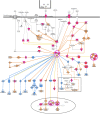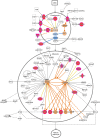Effect of breed and dietary composition on the miRNA profile of beef steers divergent for feed efficiency
- PMID: 39209905
- PMCID: PMC11362461
- DOI: 10.1038/s41598-024-70669-z
Effect of breed and dietary composition on the miRNA profile of beef steers divergent for feed efficiency
Abstract
Identifying and breeding cattle that are more feed efficient is of great benefit to beef production. Additionally, it is crucial that genes contributing to feed efficiency are robust across varying management settings including dietary source as well as being relevant across contrasting breeds of cattle. The aim of this study was to determine miRNAs that are contributing to the expression of residual feed intake (RFI) across two breeds and dietary sources. miRNA profiling was undertaken in Longissimus dorsi tissue of Charolais and Holstein-Friesian steers divergent for RFI phenotype following two contrasting consecutive diets (high-forage and high-concentrate). Ten miRNA were identified as differentially expressed (adj. P < 0.1) across the breed and diet contrasts examined. Of particular interest was the differential expression of miR-2419-5p and miR-2415-3p, both of which were up-regulated in the Low-RFI Charolais steers across each dietary phase. Pathway analysis of target mRNA genes of differentially expressed miRNA revealed enrichment (P < 0.05) for pathways including metabolic related pathways, insulin receptor signalling, adipogenesis as well as pathways related to skeletal muscle growth. These results provide insight into the skeletal muscle miRNAome of beef cattle and their potential molecular regulatory mechanisms relating to feed efficiency in beef cattle.
© 2024. The Author(s).
Conflict of interest statement
The authors declare no competing interests.
Figures




Similar articles
-
An across breed, diet and tissue analysis reveals the transcription factor NR1H3 as a key mediator of residual feed intake in beef cattle.BMC Genomics. 2024 Mar 4;25(1):234. doi: 10.1186/s12864-024-10151-2. BMC Genomics. 2024. PMID: 38438858 Free PMC article.
-
Effect of breed and diet on the M. longissimus thoracis et lumborum transcriptome of steers divergent for residual feed intake.Sci Rep. 2023 Jun 3;13(1):9034. doi: 10.1038/s41598-023-35661-z. Sci Rep. 2023. PMID: 37270611 Free PMC article.
-
The effect of breed and diet type on the global transcriptome of hepatic tissue in beef cattle divergent for feed efficiency.BMC Genomics. 2019 Jun 26;20(1):525. doi: 10.1186/s12864-019-5906-8. BMC Genomics. 2019. PMID: 31242854 Free PMC article.
-
An integrative transcriptome analysis indicates regulatory mRNA-miRNA networks for residual feed intake in Nelore cattle.Sci Rep. 2018 Nov 20;8(1):17072. doi: 10.1038/s41598-018-35315-5. Sci Rep. 2018. PMID: 30459456 Free PMC article.
-
Review: Biological determinants of between-animal variation in feed efficiency of growing beef cattle.Animal. 2018 Dec;12(s2):s321-s335. doi: 10.1017/S1751731118001489. Epub 2018 Aug 24. Animal. 2018. PMID: 30139392 Review.
Cited by
-
Complement 3 (C3) within the hypothalamic arcuate nucleus is a potential key mediator of the effect of enhanced nutrition on reproductive development in young bull calves.BMC Genomics. 2025 May 9;26(1):466. doi: 10.1186/s12864-025-11656-0. BMC Genomics. 2025. PMID: 40346477 Free PMC article.
References
-
- Manafiazar, G. et al. Methane and carbon dioxide emissions from yearling beef heifers and mature cows classified for residual feed intake under drylot conditions. Can. J. Anim. Sci.100, 522–535 (2020). 10.1139/cjas-2019-0032 - DOI
MeSH terms
Substances
Grants and funding
LinkOut - more resources
Full Text Sources
Molecular Biology Databases

